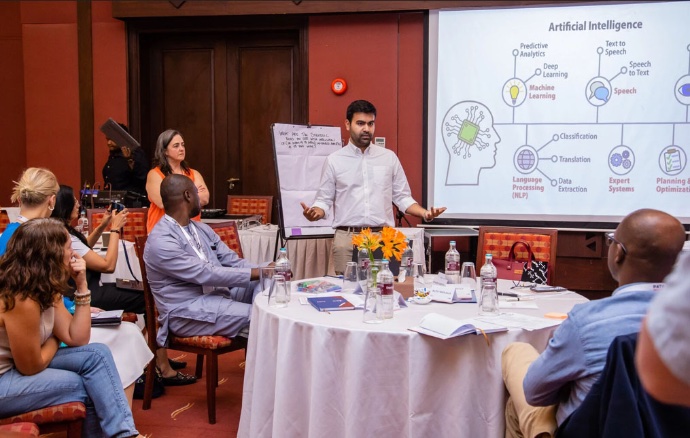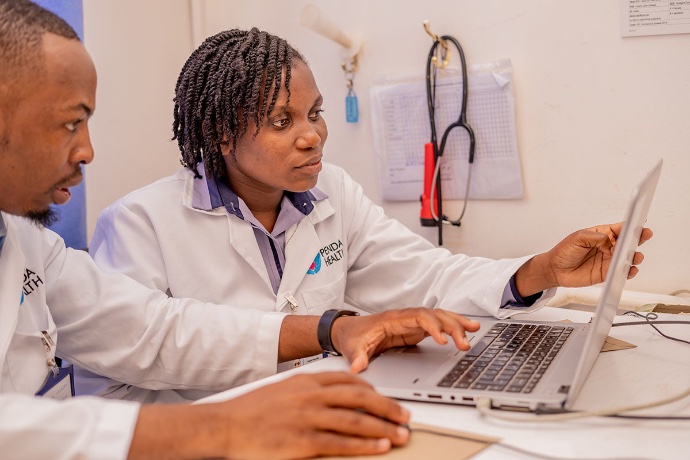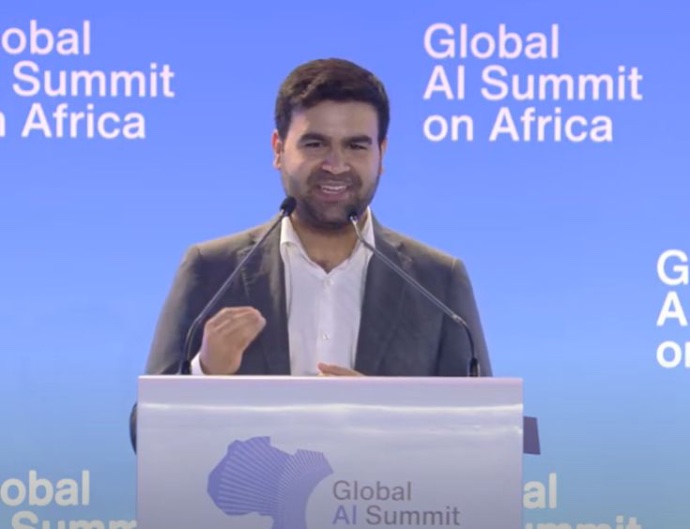By Amber Cortes

Prof. Bilal Mateen, the inaugural Chief AI Officer at PATH, presenting about AI for Health at the PATH Global Leaders meeting. Photo: PATH
Prof. Bilal Mateen, the inaugural Chief AI Officer at PATH, presenting about AI for Health at the PATH Global Leaders meeting. Photo: PATH
Artificial intelligence is rapidly transforming industries worldwide, and global health is no exception. At the forefront of this transformation is PATH, a global health organization leveraging AI not just as a tool for research but as a cornerstone of its strategy to improve public health.
“It wasn’t an overnight decision,” says Prof. Bilal Mateen, the inaugural Chief AI Officer at PATH. PATH has been engaging with and exploring the potential of AI-enabled tools for the past decade. But now, there’s been a shift towards PATH’s AI approach in both focus and priorities.
Leading the Pack, Building the Field
The shift, including appointing Mateen, signaled an intentionality on the part of PATH, as well as an effort to lean into its role as a field-builder rather than just a casual do-er.
“It’s not just that PATH wants to do a couple pilots of AI in health,” says Mateen. Rather, PATH is positioning itself to become a global leader in AI for public health. “And I’ll be honest it takes some degree of hubris to believe that we can.”
And it’s been quite a ride so far—PATH has been exploring the potential of AI for everything from supporting health workers to improving diagnostic and treatment decisions, to using AI to solve supply medical chain and distribution issues.
But Mateen recognizes that with great potential power of AI, comes great responsibility. The evolving technology can be prone to cultural and racial bias, misinterpretations, and connectivity challenges in low-resource settings. Differing regulatory ecosystems in both health and technology in developing countries complicate the situation too. In short, many things stand in the way of realizing the potential of AI, or more likely, doing so in inequitable ways.
At PATH, Responsible (AI) Means Inviting Oversight
PATH is a leader in working with governments to introduce and scale health innovations. Decades of building the relationships and expertise to help governments think through the opportunities of emerging technologies, like AI, and developing the policies and regulations to effectively safeguard against the risks, makes the organization relatively unique. But sometimes this means having to slow down to get the right guardrails in place; to ensure that only innovations which are safe and effective reach the bedside.
Mateen is often a sobering voice in the room, reminding donors and partners alike that, “we need to think about which regulator we’re going to speak to if we’re going to do that.”
‘Move fast and break things,’ a phrase common to tech disruptors, is something Mateen sees more as a balancing act.
“There are others in the ecosystem that I would argue are moving faster [regarding new technology implementations] with less consideration,” says Mateen. “And there are a lot of people that would like me to move a lot faster. But part of our commitment at PATH is that I will move as fast as I can make the ecosystem go without breaking too much,” Mateen explains. Which in reality isn’t that much slower, as his team’s work to date illustrates!
Evidence of (Cost) Effectiveness Is Crucial to Our Collective Success
“We are going to randomize 9000 people and figure out whether this tool is effective,” explains Mateen. “And that’s pretty close to the speed at which Gen AI based innovations are coming out.
Mateen is referring to PATH’s groundbreaking randomized controlled trial (RCT) in Nairobi, Kenya which will assess the impact of a Large Language Model (LLM)-based AI tool on clinical decision-making in low- and middle-income countries.
As the largest trial of its kind in Africa, this study will evaluate whether AI can improve the quality of care by assisting primary healthcare clinicians with diagnosis and treatment recommendations.
One of the biggest issues physicians, nurses, and other healthcare providers in the region face is burnout, with prevalence estimates ranging from 40% to 80% among healthcare providers according to a 2019 study published in BMC Public Health. Clinicians are overworked, under-resourced, and often in high-stress environments.
Conducted in collaboration with the Kenya Paediatric Research Consortium, the University of Birmingham, and Penda Health, the Nairobi trial seeks to provide real-world evidence for AI’s effectiveness in strengthening healthcare systems and determine if providing clinicians with an AI consult tool can reduce missed diagnoses, unnecessary patient visits, and improve adherence to guideline-based care.

Penda Health clinicians Oscar Murebu and Naomi Ndwiga review information in the clinic’s electronic medical record, which includes an integrated AI consult tool for clinical decision support. PATH and Penda Health recently launched a randomized controlled trial to generate evidence on the impact of the AI consult tool on patient outcomes. Photo: PATH/Waithera Kamau
“What we’re focused on is: is there a benefit to the patient? I’m still interested in whether the large language model is accurate. Whether it’s diagnosing things correctly,” says Mateen “But we have seen time and time again with the integration of AI into healthcare settings, even when it is more accurate than a doctor, that isn’t enough to assume that it will benefit patients.” It comes down to the complexity of health systems, the many moving parts, and the fact that making a single cog more efficient doesn’t guarantee that the machine will work more effectively, explains Mateen.
That’s why you need these large research studies, and a focus on patient-centered outcomes, of which there have been very few in low-resource settings around the world – less than a dozen to be exact. It’s all with a view to equipping decision makers with the evidence required to allocate the scarce resources available.

Bilal presenting at the Global AI Summit on Africa where he moderated a panel on “Innovating for a Healthier Future,” a conversation that highlighted African innovation in AI for Health and the key steps countries and health care systems need to take to prepare for and effectively harness the AI revolution. Photo: PATH
A Sustainable AI-Enabled Future
“There will never be enough money to address the burden of disease that we see, not just in low resource settings, but globally. The amount of money we would need to shift into our health budgets to get quote, unquote, ahead of the problem is enormous. And so, we’re seeing AI as an opportunity to help us stretch every dollar.”
To Mateen, the Nairobi trial represents just the beginning of what could be a global shift in how technology supports frontline health workers. The future of AI in global health is unfolding right now, with more direct-to-consumer technologies, prevention and prediction models for non-communicable diseases (NCDs), and that can run on phones in low-bandwidth setting are coming down the pipeline.
“I think that’s going to be transformative,” says Mateen. “But there is a lot of work left to do to get it right.”